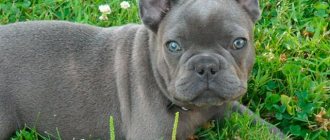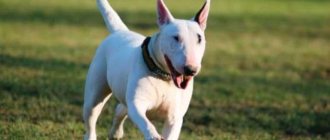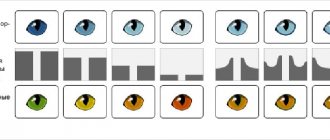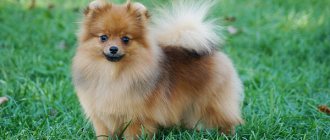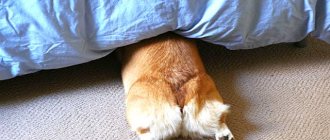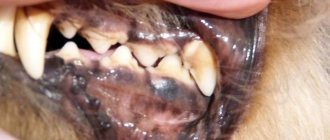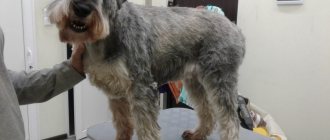Miniature Schnauzers, despite their small size, have an independent and stubborn disposition. Therefore, you should not perceive them as complete decorative lap dogs - they know their worth and will definitely remind their owner of this. Representatives of this breed are distinguished by their activity, playfulness, desire to always be in the center of attention and fairly high intellectual abilities, making them easy to train.
Due to the fact that Miniature Schnauzers are the result of crossing dogs of different breeds, their coat can come in a variety of colors. But according to the standard, only absolutely black (the undercoat should also be this color), pepper and salt, black and silver and white with a snow-white undercoat are acceptable .
Pepper and salt
This group includes Miniatures with various shades of gray. The ends of the hair have a slight silver tint.
This is the most common color among representatives of this breed.
The pepper color is distributed evenly throughout the coat. And the undercoat may be gray. Some areas of their face, hair inside their ears, chest, and tips of their paws are light in color. This color is considered the most standard in the Miniature Schnauzer breed, so owners take special care of their pets.
Standard colors of miniature schnauzer
Pure black with black undercoat . The guard hair is glossy, rich black, and the undercoat is soft, matte black. Puppies are born black and remain black all their lives, only in old age the color can acquire a dark gray tint. The coat color of most dogs does not change. However, small white markings on the chest and legs do not affect the purity of the overall color.
Pepper and salt. This color of the miniature schnauzer is the most common. It combines different shades of gray, from silver to dark steel. There is a slight silver color at the ends of the hair. The peppery tint is evenly distributed. The undercoat can be any shade of gray. Pepper and salt dogs have light eyebrows, cheeks, chin, hair inside the ears, chest, “socks” on the paws, the area under the tail, and the inside of the hind legs.
Black with silver . Solid black with silvery almost white markings. The guard hair and undercoat are black. There are white marks above the eyes, on the beard, cheekbones, throat, chest (front), pasterns, paws, in the anus, on the inside of the hind legs. Unscrupulous breeders call this color a phantom, which it is not, but many are willing to pay a large sum for such a rare color. Dogs with pepper and salt hair can easily be confused with black and silver dogs, which is what scammers take advantage of. But in pepper-and-salt puppies, the hair behind the ears and in the area of the hock joints is light or brown, copper in color (with age, the copper shade lightens and becomes silver), and in black-and-silver puppies these areas are always dark. Black and silver puppies are born with bronze markings on the eyebrows, muzzle, chest, legs, under the tail, inside of the ears; with age, the coat becomes silvery white. Moreover, the intensity of the dirty bronze shade can be different.
Pure white with white undercoat . Puppies are born white and remain white throughout their lives. In puppies, the area of the ears, around the nose and paws looks almost bald, but as they grow older, these areas become overgrown with hair, this phenomenon is considered completely normal. The nose and paw pads are pink from birth, but after two weeks they become completely black. Miniature Schnauzers have dark skin color and black eyes. It is important to remember that puppies born cream or any other light shade become white with age, but their color can no longer be called pure white with a white undercoat.
Other
Breeders do not specifically breed puppies of unusual colors. But sometimes Miniatures appear with a color that is not considered standard. And even if they are not allowed to participate in exhibitions, they will become wonderful, loyal friends.
Chocolate
A miniature schnauzer of this color looks very beautiful and unusual. Usually its fur is dark brown with a black tint.
At the same time, sometimes they have white or beige spots on the chest, paws and chin. Usually their eyes are brown or greenish-yellow, less often blue. In any case, a dog with this coloring is not allowed to participate in the exhibition.
Chocolate and tan
Quite an unusual color. It is very rare, as well as completely chocolate. The coat has a beautiful brown tint, and the tan marks are a soft cream color.
Such a dog is exceptionally beautiful and usually attracts everyone's attention everywhere. Over time, the marks become lighter and may even become snow-white. This color looks very impressive, but you will have to forget about exhibitions.
White chocolate
Representatives of this beautifully named color have snow-white fur distributed over the entire body, but there is either a dark line or a large spot along the spine.
Some Zvergs have creamy shades and dark hair that become lighter and lighter over time, and then they become completely white. In this case, you can fully count on participating in the exhibition, if, of course, you need it.
Spotted and Merle
Sometimes, erroneously, this color option is called marble by analogy with other breeds, for example, the Shetland Sheepdog Sheltie. Dogs with this color are distinguished from others by chaotically located dark markings on a white or cream coat.
Over time, the spots can change both size and shade, and if the puppies had copper or bright brick-colored markings at birth, they gradually become significantly lighter.
Taupe
Their colors are somewhat similar to the standard pepper and salt. But the gray-silver shade is diluted with brown hairs. Miniature Schnauzers of this color appear from representatives of the pepper color.
Even though representatives of this group do not take part in exhibitions, they still look beautiful. In any case, you can be proud that this color is extremely rare.
Health
- Cataract: Clouding of the lens of the eye, resulting in poor vision.
- Entropion: The eyelid rolls inward, irritating or injuring the eyeball.
- Progressive retinal atrophy (PRA).
- Urinary stones : cause problems with urination, blood in the urine, and the need to urinate more often than usual.
- Congenital myotonia: This is an inherited musculoskeletal disorder similar to muscular dystrophy recently discovered in miniature schnauzers. Symptoms begin when puppies are a few weeks old. They have difficulty standing up, their skin is hard, and they jump when they run.
- Von Willebrand's disease: a blood clotting disorder.
- Congenital megaesophagus: dilation of the entire esophagus and decreased peristalsis, the lower esophageal sphincter is either closed or there is no opening reflex causing food and liquid to be retained in the dog's esophagus, causing him to regurgitate the food.
Origin story
The first mentions of miniature schnauzers date back to the beginning of the 18th century. At that time, middle-sized schnauzers were popular in Germany and beyond its borders. To get a smaller variety that had the same skills, appearance, and character, breeders mixed them with poodles, spitzes, and some other dwarf breeds.
The breeders managed to achieve the desired result. The first puppies appeared, which are a smaller copy of the Schnauzer. A problem was immediately discovered: the change in size affected the color of the quadrupeds. Therefore, it took more years to regulate the shades of wool.
The result exceeded all expectations. In 1888, the presentation of the dwarf schnauzer took place. Since that time, an official description of the breed has been recorded, which breeders still adhere to. The Miniature Schnauzer was brought to Russia about 40 years ago. Representatives of the breed immediately fell in love with local residents. Dog kennels began officially breeding the breed in 1980.
Character
The character of the miniature schnauzer is unique, which is explained by the unique breeding of the breed variety. Miniature schnauzers, giant schnauzers - large varieties are noble dogs, distinguished by courage, protective tendencies, and the ability to stand up for the owner. Their smaller copy, the miniature schnauzer, also has these qualities. Dog handlers call him a big little dog; behind his outward fragility lies a strong character.
The Miniature Schnauzer is wary of all strangers and it is very difficult to gain his trust. A dog will never allow a stranger to command it. It’s amazing to watch how miniature dogs interact with representatives of other breeds, even the largest ones: they behave as equals and do not allow them to show superiority over them. They will never tolerate humiliation; they submit only to the strongest.
At the same time, the Miniature Schnauzer is good-natured, cheerful, and playful with its owner and his entire family. He treats other animals in the house well. The sensitivity and sentimentality of the four-legged dog do not allow him to tolerate separation from his owner normally; he begins to feel very sad. Such feelings force the animal to be submissive to the owner. Miniatures love children living in the same house. The pet will be able to accompany the child on a walk, replacing his toys. He views the owner's children as his property that needs to be protected, so he is ready to tolerate a lot from them.
Conditions of detention
Miniatures are small dogs that can easily fit in an apartment. However, they require active walks and games.
Miniature Schnauzers require long walks and exercise in the fresh air, such as jogging. You need to walk with them at least three times a day in any weather.
With timely trimming, the miniature schnauzer will not leave fur behind, and with a harmonious relationship with the owner and household members, he will become a wonderful companion.
How much does it cost and where to buy
The National Breed Club (NKP) is a Miniature Schnauzer club registered in Russia, engaged in breeding work, exhibition activities, and popularization of the breed.
More than 20 kennels in Moscow, St. Petersburg, Ufa, Rostov-on-Don, Vyborg, Kaliningrad, and Nizhny Novgorod are engaged in breeding and selling dogs in Russia.
The price of puppies varies:
- elite puppies from the nursery from parents of exhibition winners - from 30,000 rubles ;
- puppies with a pedigree that fully comply with the standard 15,000 - 30,000 rubles ;
- puppies with defects, with a note in the pedigree “not for breeding” and puppies without documents - from 10,000 rubles .
Features of coat care depending on the color of the miniature
Caring for the coat of mini-dogs such as miniature schnauzers is relatively simple. They practically do not shed, so it is enough to brush them 2-3 times a week. It is worth remembering that this breed is a wire-haired breed, which means that grooming is contraindicated for it (with the exception of trimming the shape of the fur on the beard and paws). Therefore, it is better to take your pet to a professional groomer. This fact is especially worth considering for owners of dark dogs: there is an opinion that black wool is harsher than light ones.
Black and silver miniature schnauzers, whose participation is planned in exhibitions, require special care. To maintain whiteness on the face, chest and paws, it is worth using special shampoos that prevent darkening of the coat.
Miniature Schnauzers can come in different colors. Therefore, every breed lover is free to choose a pet in accordance with their own aesthetic preferences. However, before this, it’s worth thinking about: is the dog taken only as a companion, or is there a desire to raise a champion? In the latter case, caring for the animal is also important: improper grooming or faded marks can be a reason for refusal of registration at the exhibition.
Breeders' advice on choosing a puppy
When buying a miniature schnauzer puppy, it is important not only to choose a healthy individual, but also to purchase the animal from a kennel with a good reputation. You should avoid bird markets and unverified breeders offering to purchase a dog of dubious origin and without a pedigree. Such an animal may turn out to be not purebred and sick, having a number of not only somatic, but also mental problems.
Having studied the reviews about a particular nursery offering to purchase miniature puppies, you need to visit this establishment in person and evaluate the conditions in which the dogs are kept. Enclosures should be thoroughly cleaned, and there should be no unpleasant specific smell of “dog” or feces in the room. In addition, the breeder must present documents confirming the breed and noble origin of the dogs.
If the nursery meets the listed requirements and there are no complaints about the living conditions of the animals, you can begin choosing a specific puppy.
First of all, you should look at the parents of the future pet. They should be well-fed and well-groomed, with shiny coat and a lively, meaningful look. After this, it’s worth watching the feeding of the doggies; healthy babies consume food at a record speed and with an enviable appetite. In addition, puppies must be constantly on the move unless they are sleeping. A sad and melancholic dog is most likely not entirely healthy.
You can choose an active pet in the old proven way: sit down and call the kids. The smartest, most curious and brave one will run up first: little miniatures should not be cowardly. If a dog hides and refuses to go to a person, this indicates, at a minimum, isolation and psychological problems, and possibly the presence of serious illnesses.
In addition, you should examine the baby you like and pay attention to the following points:
- coat condition;
- cleanliness of ears;
- shade of the mucous membrane in the mouth;
- tooth color and correct bite;
- no discharge from the eyes.
After purchasing a pet, you should immediately show it to a specialist and get detailed advice on the care, feeding and maintenance of animals. It will also be necessary to carry out vaccinations in a timely manner to prevent a number of dangerous diseases.
